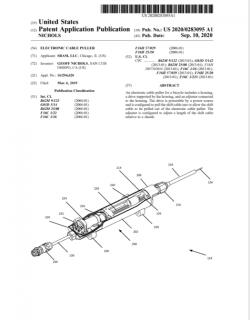Editor’s note: A version of this article ran in the November issue of BRAIN. It has been updated with more information about the two brands that sell products with similar features as the SRAM patent.
By Alan Coté
SRAM’s recent patent application for an “Electronic Cable Puller” points to the increased integration of e-bikes. But it also might lead to some conflict between SRAM and two U.S. companies that already offer products using technologies similar to what SRAM describes in the application.
With e-bikes surging in popularity both in the U.S. and globally, manufacturers have been considering what else a large-capacity e-bike battery could power in addition to propelling a bike. Headlights, taillights, and integrated computer displays are obvious accessories to draw juice from an e-bike battery. Magura has shown heated grips that use e-bike battery power, and Fox’s E-Live Valve uses the bike battery to control suspension.
But SRAM has its eyes on derailleurs. SRAM’s U.S. patent application for an “Electronic Cable Puller” was published on Sept 10, with Geoff Nichols as the sole inventor. It describes a wireless shifting system that’s centered around an electronic cable puller, which mounts to the frame. The cable puller is powered by an e-bike’s battery.
 With SRAM’s existing eTap electronic shifting system, a handlebar-mounted switch communicates wirelessly with a bike’s derailleurs. An eTap derailleur has no cable, and uses an internal motor to actuate shifts, powered by a small removable rechargeable battery. With all that technology bundled into a small package, an eTap rear derailleur is among the priciest rear derailleurs sold, starting at $490 MSRP for the Force model. The battery lasts for about 60 hours of riding between charges.
With SRAM’s existing eTap electronic shifting system, a handlebar-mounted switch communicates wirelessly with a bike’s derailleurs. An eTap derailleur has no cable, and uses an internal motor to actuate shifts, powered by a small removable rechargeable battery. With all that technology bundled into a small package, an eTap rear derailleur is among the priciest rear derailleurs sold, starting at $490 MSRP for the Force model. The battery lasts for about 60 hours of riding between charges.
This design in the application borrows the concept of a handlebar switch that transmits a wireless signal to initiate a shift. But instead of that signal being received by an electronic rear derailleur, it’s received by a frame-mounted box attached to the right chainstay (or another place on the frame). The box includes a wireless receiver, of course, along with a motorized cable-pulling apparatus. The arrangement therefore allows use of a conventional cable-actuated rear derailleur – it’s like a robotic hand that operates a traditional derailleur.
The patent application describes an electric cable puller that “… may be powered by the centralized battery of an electric power-assist bike (“e-bike”) and may not be internally powered.” (emphasis on "not" added). Why not include a removable battery with the cable puller? There are numerous reasons why SRAM may have narrowed the patent application to exclude that arrangement, though as is common practice SRAM declined to comment on this patent application.
One reason may be that SRAM does not want to develop products that risk cannibalizing its own eTap product line – though a chainstay-mounted box is far less sleek than a rear derailleur with integrated electronics.
Another hurdle may be related to intellectual property, as there’s prior art around a wireless electronic cable puller. X-Shifter and Archer Components each market similar products but with internal batteries, instead of a relying on an e-bike battery.
 X-Shifter (founded by Paul Gallagher, a former SRAM engineer) launched with a Kickstarter campaign in 2016. Gallagher told BRAIN he was "shocked" to learn about the new SRAM patent applications.
X-Shifter (founded by Paul Gallagher, a former SRAM engineer) launched with a Kickstarter campaign in 2016. Gallagher told BRAIN he was "shocked" to learn about the new SRAM patent applications.
"It's almost identical to my product, even the shape of it," he said. Gallagher, who is based in Taiwan, said he has sold thousands of X-Shifters. He focuses on sales to makers of special bikes, including hand bikes and folding bikes where derailleur cable routing can be difficult. Gallagher said he has had a patent pending on his product since 2015.
"I pre-date SRAM and Archer, so I'm not worried. And I don't even mind SRAM copying me because they copied my old version. My new version is vastly improved," he said.
Archer Components' Brandon Rodgers was granted a patent in December 2019. Archer has sold about 3,500 of its D1X systems since beginning production in 2018. Unlike the X-Shifter, Archer focuses more on marketing to enthusiasts.
Archer co-founder and GM, Devin Carlson, said interest in the D1X continues to build. The D1X is customizable for the number of sprocket teeth and spacing, so with this year’s industry shortage of repair parts, it comes in handy for shops and consumers trying to get old bikes operating again. If you can't find a shifter to mate with a bike's obsolete rear derailleur, a system like the D1X might be just the thing. And it remains an item for riders who want wireless shifting but are wary of putting an expensive electronic rear derailleur on a mountain bike, Carlson said.

Carlson said he has had no contact with SRAM and a SRAM spokesman declined to comment on the similarity between the Archer D1X and the X-shifter products and SRAM's patent application.
Carlson said Archer also has been developing a version of its product that runs off an e-bike battery and has built prototypes. “The great thing about using the e-bike battery is you have infinite power supply. With 12 volts available our e-bike-powered shifter is badass. It just shifts so much faster (than with smaller battery),” he told BRAIN.
SRAM’s focus on e-bike battery power for the design speaks to the potential market. Electronic shifting is undeniably smooth, fast, and user-friendly. A very short run of cable may reduce the frequent cable tension adjustments needed by conventional derailleurs. An e-bike typically has its battery charged routinely, and this new design insures there’s no concern about having to keep track of topping-up a separate derailleur-specific battery. Such an arrangement would be especially suited to fleet and rental bikes, which are often used by new or infrequent riders who find electronic shifting simple to use.
The shift buttons do require a battery to transmit their wireless signal, but the battery life is so long – about 1,500 hours on SRAM’s eTap system – as to not be an issue. Rear derailleurs are also vulnerable to damage, and with this design only a conventional lower priced unit is exposed, with the costly electronics and motor separate and tucked away.
SRAM’s patent application only recites a cable puller for rear derailleurs, with SRAM known for championing 1x drivetrains. But the same idea of tapping-into an e-bike battery for power could be employed for other components as well. Expect to see more in the coming years — from alternative drivetrain technologies to dropper posts to dashboards.
Alan Coté is a Registered Patent Agent & principal of Green Mountain Innovations LLC. He’s a past contributing writer to Bicycling, Outside, and other magazines, and a former elite-level racer. He also serves as an Expert Witness in bicycle-related legal cases.






